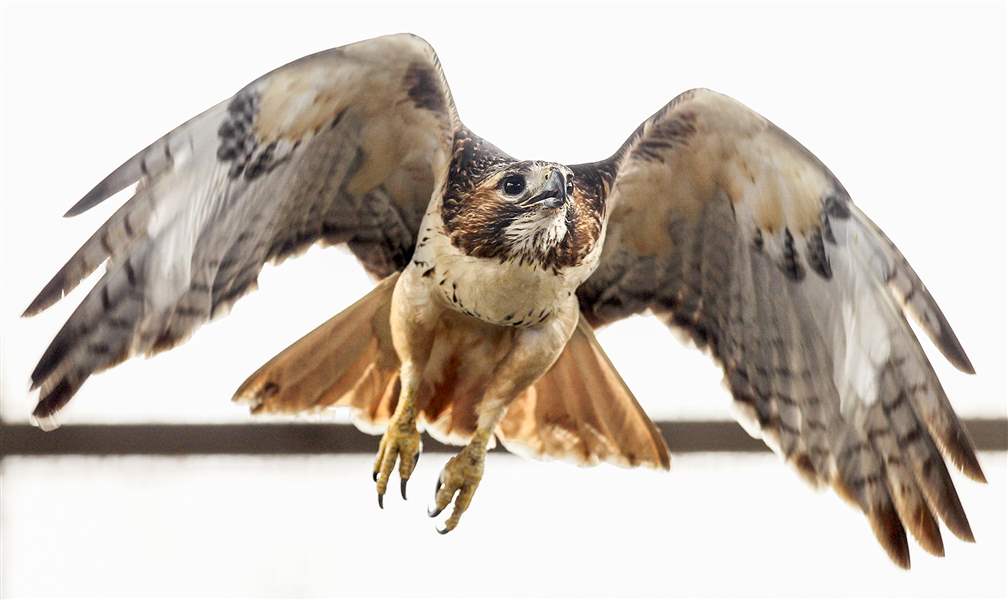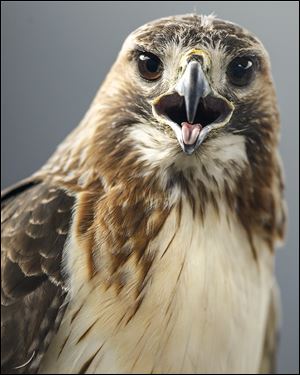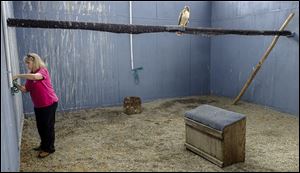
Injured hawk soaring through rehabilitation
Center helping bird that was partially paralyzed
3/28/2016
Nature’s Nursery, a wildlife rehabilitation center near Whitehouse, Ohio, has been treating a red-tailed hawk that was partially paralyzed after a spinal injury. The hawk is making progress in therapy and could be released in a few weeks.
THE BLADE/JEREMY WADSWORTH
Buy This Image

Nature’s Nursery, a wildlife rehabilitation center near Whitehouse, Ohio, has been treating a red-tailed hawk that was partially paralyzed after a spinal injury. The hawk is making progress in therapy and could be released in a few weeks.
It’s been a long road, but an injured adult red-tailed hawk is in the final stages of recovery before she will return to the wild.
A Rossford resident found the bird on the ground in early February. Nature’s Nursery, the region’s wildlife rehabilitation center near Whitehouse, took her in.
“She had a little movement in her legs, but she couldn’t use them, couldn’t stand on them, and her feet were all balled up,” said Laura Zitzelberger, operations manager at the center.
The hawk apparently suffered some spinal trauma and was partially paralyzed. She retained use of her wings, but had no control of her legs or feet.
“She could have been clipped by a car or hit an object like a branch or a power line,” Mrs. Zitzelberger said, noting there were no bone fractures.
Nature’s Nursery frequently takes in animals with spinal or head trauma, particularly birds. Whether they recover is often a toss-up.
“Sometimes we can reverse the problem, and other times we see no improvement regardless of what we do,” she said. “As long as we’re still seeing some improvement, we keep going.”

Nature's Nursery is successfully rehabbing a red tailed hawk that came in a few weeks ago with partial paralysis after a spinal injury.
For the hawk, volunteers fashioned balls out of bandaging and strapped them to her feet to prevent her toes atrophying in a closed position. She received anti-inflammatory medications and initially had to be force fed.
After a couple of weeks, the bird was able to prop herself up on her legs but could not stand, similar to a person on their knees.
The hawk’s progress plateaued for a while at this stage, but the organization continued doing physical therapy to work her legs and toes.
“It’s really pretty simple, just making sure you’re doing it in a controlled fashion so you’re not doing more damage,” Mrs. Zitzelberger said.
Slowly, the bird regained the ability to stand, use her feet to eat mice, walk, and perch. She is now building muscle and stamina in the center’s large flight cage. She could be released in a few more weeks, provided she can hunt live prey.
“Once she passes these tests we have, we’ll send her right back to where she came from in Rossford, hopefully in time to find a mate,” said Executive Director Steve Kiessling.
Red-tailed hawks are federally protected as migratory birds and are the most common raptors in Ohio. They can often be seen soaring over fields or perched on trees and telephone poles along the roadside searching for small mammals to hunt.

Laura Zitzelberger, operations manager at Nature’s Nursery, lowers a perch for a red-tailed hawk. When the hawk was found in February, she could not control her legs or feet. Now she has the ability to stand, use her feet to eat mice, walk, and perch.
“They are very important indicators of environmental conditions,” said Jim McCormac, avian education specialist with the Ohio Department of Natural Resources’ Division of Wildlife. “If you see a lot of them, it’s a good thing.”
Mr. Kiessling said even though the hawks are very common, each individual bird plays an important role.
“They are part of the ecosystem, and everything has its place,” he said. “They were here long before we were.”
Because red-tailed hawks are easy to see in the wild, Mr. McCormac said, they capture the public’s attention and provide an avenue for wildlife and conservation education.
“They get a lot of people interested in nature,” he said. “People love a good bird of prey. And a lot of these animals, the reason they are in these [rehabilitation] places, is because of us.”
Many animals arrive in grim condition and don’t make it, Mrs. Zitzelberger said. Successes like the red-tailed hawk provide relief and inspiration.
“Working on these kinds of cases and having that end up being such a good outcome, that keeps everybody here going,” she said.
Donations to Nature’s Nursery may be made at natures-nursery.org, or by sending a check to P.O. Box 2395, Whitehouse, OH, 43571.
Contact Alexandra Mester: amester@theblade.com, 419-724-6066, or on Twitter @AlexMesterBlade.